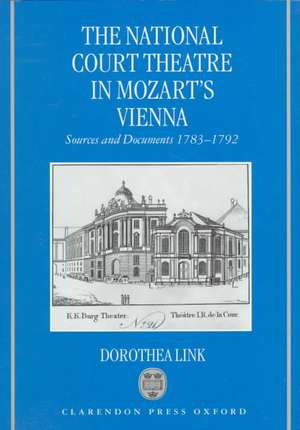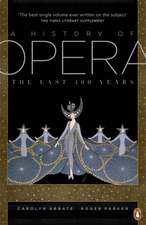The National Court Theatre in Mozart's Vienna: Sources and Documents 1783-1792
Autor Dorothea Linken Limba Engleză Hardback – 6 mai 1998
Preț: 1763.42 lei
Preț vechi: 2679.40 lei
-34% Nou
Puncte Express: 2645
Preț estimativ în valută:
337.41€ • 352.33$ • 278.64£
337.41€ • 352.33$ • 278.64£
Carte tipărită la comandă
Livrare economică 04-10 aprilie
Preluare comenzi: 021 569.72.76
Specificații
ISBN-13: 9780198166733
ISBN-10: 0198166737
Pagini: 560
Ilustrații: 5 text-figures
Dimensiuni: 174 x 248 x 34 mm
Greutate: 1.11 kg
Editura: OUP OXFORD
Colecția OUP Oxford
Locul publicării:Oxford, United Kingdom
ISBN-10: 0198166737
Pagini: 560
Ilustrații: 5 text-figures
Dimensiuni: 174 x 248 x 34 mm
Greutate: 1.11 kg
Editura: OUP OXFORD
Colecția OUP Oxford
Locul publicării:Oxford, United Kingdom
Recenzii
a unique documentary compilation.
The vitality of the National Court Theatre, including its rich repertory and colourful community of officials, performers and patrons, lies burried not only within the minutiae of countless archival documents and records, some of which are presented here, but also within our own constructions of that material. Dorothea Link's invaluable accompanying commentary and annotations begin to explore this vitality, and her meticulous Performance Calendar and other sources presented here will benefit those committed to their tasks as historians.
The National Court Theatre in Mozart's Vienna is not a book to be read from cover to cover. It is much more useful than that, since it is destined to be a basic reference tool for opera scholars, indeed social historians too, working on opera in Vienna in the 1780s and 1790s. It fulfils three fundamental needs. Firstly, it provides a calendar of performances for the period 1782-92 that surpasses in detail and coverage that found in the hitherto unrivalled work of the two theatre historians, Franz Hadamovsky and Otto Michtner; the theatres include the two summer palaces of Schoenbrunn and Laxenburg as well as the two court theatres in the city itself, the Burgtheater and the Kaerntnertortheater; also, details of the many benefit concerts during Lent are systematically presented for the first time.
Secondly, it includes all the references in the diaries of Karl Zinzendorf to musical and theatrical performances in Vienna during the same period. Although the documentary value of the Zinzendorf diaries has been appreciated since the 19th century, their sheer size -- 76 volumes covering the social life of a music-loving aristocrat in Vienna from 1752 to 1813 -- and perhaps the rather laconic nature of the entries themselves -- waxing eloquently did not come easy to Zinzendorf -- have always defeated any plans to publish them in a modern edition. Historians of all kinds have been through the material for specific purposes several times, and there have been editions of portions of the material before, but Link's collection is especially welcome for her copious and informative footnotes.
Thirdly, the book includes transcriptions of payments to singers, players, librettists, copyists and other personnel who worked at the court theatres during this period, plus subscription lists of those who attended. Link's introductions to her material and her summary remarks on the makeup of theatrical life in Vienna during the reign of Joseph II are models of clarity and, for anybody who has had experience of working in the tangled web of Viennese archival sources, objects of envy too. By an appropriately provocative coincidence, three of the most valuable Mozart books discussed above (those by Eisen, Halliwell and Link) are published by Oxford University Press. For reasons that have never been satisfactorily explained, OUP decided to shut its UK music book division last summer.
Now, for the first time, an excellent English publication gives the chronology of all performances - music and spoken theater - at all of the court theaters during Mozart's career in Vienna ... Link has used and listed rich sources of documentation ... All previous works relating to the Burgtheater and its chronology for the period under discussion now have been superseded with Link's new book ... Link's research is an extremely important contribution not only to music scholarship, but also for cultural studies and the histories of opera and theater. Link's judicious reproduction of documents and the detailed chronology will give scholars a much clearer understanding of the unique workings of eighteenth-century theater ... No serious Mozart scholar should be without this excellent resource.
Link's... concise summaries of the institutional history of the court theatres... should be read by everyone interested in the subject, since they are by far the best available... it is the first complete published transcription of the relevant sections of Count Karl Zinzendorf's famous diary: all mentions of theatrical and musical events and occasions are included. Each part of the book has its own particular joys; each could be the starting-point for many inquiries: and different readers will no doubt find a variety of connections between them.
The remarkably full and well-documented lists she provides allow one easily to look at the repertory of a given season, and to start both putting individual works in context and looking at a season as a 'text', finding patterns and habits that suggest aesthetic and ideological issues as well as economic and practical ones. Professor Link's collection of excerpts is a great service to scholars. The transcriptions of the theatrical salaries will be of interest to those tracing the careers of singers and instrumentalists, as well as actors.
Link has given us an invaluable gift. The data she has put at our fingertips can be used to support, contradict and complicate our stories about the place of theatre in Viennese society... It is up to future scholars in the field to make the best use of this precious information... we must be grateful to... Dorothea Link... for reminding us so vividly and so thoroughly how many different sorts of raw material go into the making of art.
The vitality of the National Court Theatre, including its rich repertory and colourful community of officials, performers and patrons, lies burried not only within the minutiae of countless archival documents and records, some of which are presented here, but also within our own constructions of that material. Dorothea Link's invaluable accompanying commentary and annotations begin to explore this vitality, and her meticulous Performance Calendar and other sources presented here will benefit those committed to their tasks as historians.
The National Court Theatre in Mozart's Vienna is not a book to be read from cover to cover. It is much more useful than that, since it is destined to be a basic reference tool for opera scholars, indeed social historians too, working on opera in Vienna in the 1780s and 1790s. It fulfils three fundamental needs. Firstly, it provides a calendar of performances for the period 1782-92 that surpasses in detail and coverage that found in the hitherto unrivalled work of the two theatre historians, Franz Hadamovsky and Otto Michtner; the theatres include the two summer palaces of Schoenbrunn and Laxenburg as well as the two court theatres in the city itself, the Burgtheater and the Kaerntnertortheater; also, details of the many benefit concerts during Lent are systematically presented for the first time.
Secondly, it includes all the references in the diaries of Karl Zinzendorf to musical and theatrical performances in Vienna during the same period. Although the documentary value of the Zinzendorf diaries has been appreciated since the 19th century, their sheer size -- 76 volumes covering the social life of a music-loving aristocrat in Vienna from 1752 to 1813 -- and perhaps the rather laconic nature of the entries themselves -- waxing eloquently did not come easy to Zinzendorf -- have always defeated any plans to publish them in a modern edition. Historians of all kinds have been through the material for specific purposes several times, and there have been editions of portions of the material before, but Link's collection is especially welcome for her copious and informative footnotes.
Thirdly, the book includes transcriptions of payments to singers, players, librettists, copyists and other personnel who worked at the court theatres during this period, plus subscription lists of those who attended. Link's introductions to her material and her summary remarks on the makeup of theatrical life in Vienna during the reign of Joseph II are models of clarity and, for anybody who has had experience of working in the tangled web of Viennese archival sources, objects of envy too. By an appropriately provocative coincidence, three of the most valuable Mozart books discussed above (those by Eisen, Halliwell and Link) are published by Oxford University Press. For reasons that have never been satisfactorily explained, OUP decided to shut its UK music book division last summer.
Now, for the first time, an excellent English publication gives the chronology of all performances - music and spoken theater - at all of the court theaters during Mozart's career in Vienna ... Link has used and listed rich sources of documentation ... All previous works relating to the Burgtheater and its chronology for the period under discussion now have been superseded with Link's new book ... Link's research is an extremely important contribution not only to music scholarship, but also for cultural studies and the histories of opera and theater. Link's judicious reproduction of documents and the detailed chronology will give scholars a much clearer understanding of the unique workings of eighteenth-century theater ... No serious Mozart scholar should be without this excellent resource.
Link's... concise summaries of the institutional history of the court theatres... should be read by everyone interested in the subject, since they are by far the best available... it is the first complete published transcription of the relevant sections of Count Karl Zinzendorf's famous diary: all mentions of theatrical and musical events and occasions are included. Each part of the book has its own particular joys; each could be the starting-point for many inquiries: and different readers will no doubt find a variety of connections between them.
The remarkably full and well-documented lists she provides allow one easily to look at the repertory of a given season, and to start both putting individual works in context and looking at a season as a 'text', finding patterns and habits that suggest aesthetic and ideological issues as well as economic and practical ones. Professor Link's collection of excerpts is a great service to scholars. The transcriptions of the theatrical salaries will be of interest to those tracing the careers of singers and instrumentalists, as well as actors.
Link has given us an invaluable gift. The data she has put at our fingertips can be used to support, contradict and complicate our stories about the place of theatre in Viennese society... It is up to future scholars in the field to make the best use of this precious information... we must be grateful to... Dorothea Link... for reminding us so vividly and so thoroughly how many different sorts of raw material go into the making of art.
Notă biografică
Dorothea Link is Commissioning Editor for the New Grove Dictionary of Music














